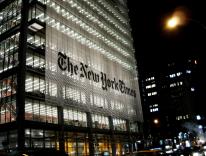Musicals blow the dust off the soul,” Mel Brooks remarks in the first moments of Broadway: The American Musical, tossing out an exuberant metaphor well suited to this terrific PBS documentary, which blasts the dust off priceless show-biz anecdotes and bits of historical footage chronicling the quintessential American art form. Premiering October 19-21 (check local listings), this handsome and well-informed six-part film traces the development of musical theater through the course of the twentieth century and up to last season, rounding things off with a few voyeuristic shots from backstage on the opening night of Wicked. Starting with its host, Sound of Music icon Julie Andrews, Broadway revels in star allure: Rex Harrison throwing a fit of pique while rehearsing My Fair Lady. Tim Robbins explaining the significance of the 1936 agitprop show The Cradle Will Rock. Nathan Lane and Matthew Broderick-as if we had not seen them enough already! But at the same time, the series places entertainment trends and innovations in the context of America’s broader experience, making it as appropriate for history buffs as for showtune junkies, not to mention all those people-you know who you are-who just can’t remember which one was Lerner and which one was Loewe.
Producer Michael Kantor honed his craft laboring on documentaries with the brothers Burns (Ken and Ric) and his own work sticks with the siblings’ favored stylistic tics: the evenly paced fluctuation between commentary by experts (in this case, the likes of Tommy Tune, John Lahr, Joel Grey, etc.) and photos or cinematic footage; the solemn narrative voiceover that gives way periodically to quotes from historical figures, read by different voices. But if his form is generic, Kantor has taken care to probe the artistic, social, and logistical complexities of this specific subject. Kicking off with the necessary reference to the legendary prototypical musical The Black Crook-a bizarre extravaganza spawned when an 1866 melodrama incorporated a French ballet troupe stranded in New York-the film trots out some old-chestnut truths of theater history, giving due emphasis to the seminality of Oklahoma!, and so on. But the film zooms in closer, too. It sometimes examines its topic from a musical angle: for instance, with a cameo by Stephen Sondheim at a keyboard, explaining the harmonies that gave that special menacing quality to the opening of Sweeney Todd. It acknowledges the power of commerce, sampling the 1970s “I Love New York” advertising campaign, which featured the ensembles of Cats and A Chorus Line.
Most important, it strikes an appropriate balance between a focus on ideas-historical observations, mostly, but also the occasional pithy abstraction, like Brooks’s-and on personalities. Anyone who has read the arts section of a paper or magazine recently knows that contemporary cultural journalism devotes most of its attention to celebrities, an approach that arguably undermines the long-term welfare of the arts. After all, if readers start to think of art exclusively as the achievement of an individual temperament, rather than as the essential activity of a society, they are less likely to feel connected to, and interested in, the creative sphere.
A PBS documentary isn’t exactly cultural journalism-a documentary tends to have a longer shelf life than most arts reporting. But the two are similar enough to make one welcome the sociological and historical perspective that’s in evidence when Broadway points out how the “racial and cultural friction” of the post-World War II era fed the work of Rodgers and Hammerstein; or when it captures theater historian Robert Kimball comparing Cole Porter’s “You’re the Top” to “the civilized embodiment of the Roosevelt recovery”; or when it brings on the New York Times’s Margo Jefferson to reflect, apropos of Porgy and Bess, that “the mark, in terms of race, of a major piece of art in America is not that it masters race” but that “it in some way is tangling with it...showing those schisms and those contradictions.”
If one can praise Kantor’s openness to concepts, though, one cannot do the same for his sense of geography. As the title makes only too clear, this series suggests throughout that the history of the musical is synonymous with the history of Broadway-those few Manhattan blocks that have monopolized most of the glamour in the American theater world, but that do not have a lock on art or innovation. Aside from a passing mention of New York’s Playwrights Horizons, which first presented Sunday in the Park with George, the documentary completely fails to acknowledge the crucial role that nonprofit, off-Broadway, and regional theaters have played in the ecology of the musical in recent decades: the contributions of such institutions as New York’s Vineyard Theatre, which launched last season’s Tony-winning Avenue Q; or the Signature Theatre of Arlington, Virginia, where Kander and Ebb worked on their musical adaptation of The Skin of Our Teeth; or the Intiman Theatre of Seattle, which recently premiered The Light in the Piazza by Adam Guettel, Richard Rodgers’s grandson and one of a new generation of daring young theater composers. If musicals do blow the dust off the soul-and this PBS series contains enough tantalizing song snippets and misty-eyed interview excerpts to convince anyone of Brooks’s dictum-the feat has been accomplished far beyond the Great White Way.
Please email comments to [email protected] and join the conversation on our Facebook page.
Share
Previous Story
THE LAST, BEST HOPE?
Next Story
Is the Market Moral? by Rebecca M. Blank and William McGurn

